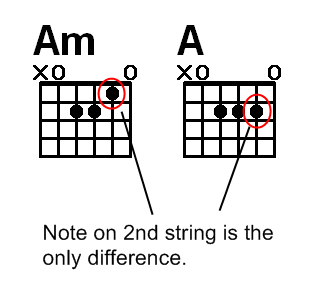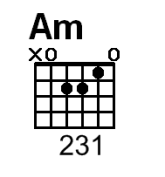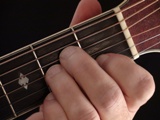Am Chord (A minor)
Lesson Goals:
♦ Learn proper fingering for the A minor (Am) chord
♦ Play the chord clearly
♦ Visualize the chord pattern
This is the first time we have introduced a minor chord to you. Every major chord on the guitar (including all the chords you have already learned) has a minor counter part.
The Am chord is formed by placing the 2nd finger on the 2nd fret of the 4th string, the 3rd finger on the 2nd fret of the 3rd string, and the 1st finger on the 1st fret of the 2nd string.
Notice the similarities between the Am and its parent, the A major chord. There is only one change we must make to an A major chord to make it become an Am chord. By simply moving the note on the 2nd fret of the 2nd string down one fret, you will turn an A major into an A minor (Am).

For future reference, note that most major chords can be converted to their minor counterpart by shifting just one note.
Big Hint! - Notice that the "pattern" or "shape" of the Am chord is identical to the pattern/ shape of the E chord. The fingering is exactly the same, just on the next strings down.



